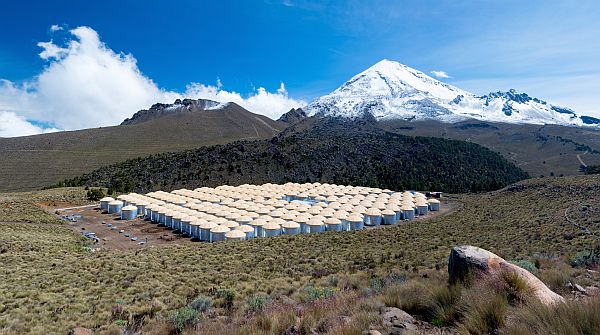Puebla, Mexico - The Sierra Negra volcano in the central Mexican state of Puebla is the site of an ambitious astrophysical project which houses the largest gamma ray observatory ever built on the planet.
After 5 years of construction, scientists in Mexico say the High Altitude Water Cherenkov Experiment or HAWC, is operating at full capacity. The facility has been hunting cosmic rays in a limited fashion since 2013.
 |
The observatory is made up of 300 tanks each holding 50,000 gallons (190,000 liters) of pure water, as well as detectors capable of sensing and recording Chernakov radiation, a flash of light made up of charged particles produced when they impact the tanks after coming through Earth atmosphere slightly faster than the speed of light.
By measuring the angle and intensity at which these particles hit all 300 sensors over time, the scientists can figure out where the gamma rays originated. The researchers hope that at an elevation of 4,100 meters and sensors arranged over 30 square meters, HAWC will provide the best environment to detect gamma and cosmic rays.
Dr. Jordan Goodman, from the University of Maryland, explained the importance of the observatory. "We've been interested for a long time in gamma rays. They are meant to point back at space differently. Gamma ray points go straight, they're light, but they're highest energy light so they let us understand where the highest energy particles in the universe come from. So our idea is to build this observatory to give us a wide field view of the sky at the highest energy," said Dr. Goodman.
Thanks to the Earth's rotation, HAWC will be able to hunt gamma rays from two thirds of the sky within a 24-hour period. The scientists hope that by determining the origin of the gamma rays, they can learn more about great cosmic events such as supernovas and black holes that produce them.
Along with mapping the highest producers of energy in distant galaxies, HAWC will also help researchers learn more about our solar system by studying the Sun.
"HAWC looks at the whole sky overhead all the time as the earth turns, so right now we're pointing there but later as the earth turns we're going to be pointing over there. So we survey more than half of the sky all the time and this technique is unusual because somebody yesterday at the conference we had said we should look at gamma rays from the sun, very high energy, no one who does not have a telescope can look at the sun but we can look at the sun because we don't use daylight, we use the gamma rays," Doctor Goodman added.
The observatory is also home to the Large Millimetre Telescope (LMT) - the world's largest single-dish steerable millimeter-wavelength telescope.
Sierra Negra, an extinct volcano to the east of the city of Puebla in central Mexico, was chosen because of its height and mild climate. While oblivious to light pollution, millimeter telescopes work best at altitudes where the level of water vapor in the air is low.
The observatory will work for 10 years, a time frame agreed with the environmental authorities at the Peak of Orizaba. Afterwards the observatory will be dismantled at the natural reserve.
Original article


